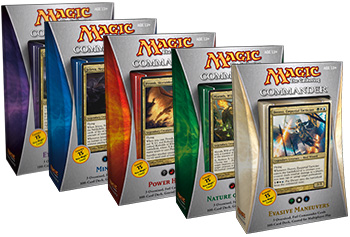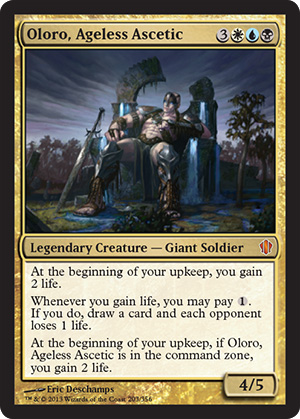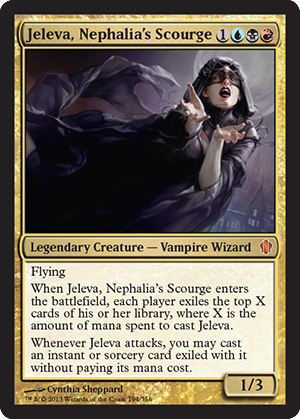|
|
|||||
| Pojo's Magic The Gathering news, tips, strategies and more! | |||||
|
|
|||||
 |
|||||
|
|
|||||

Pojo's MTG
120x90 Ad Space
|
BMoor's Magic
The
Gathering Deck Garage With all the excitement about Theros, it seems Commander 2013 has passed under the radar with surprisingly little fanfare. I suppose I understand why-- Commander is by its nature a casual format, and most of its players build their decks out of their older cards that they still have from back when they were Standard-legal. But there’s some new gems in Commander 2013 that are worth talking about. Obviously, from a Commander point of view, any new set that comes out strengthens Commander most by its legendary creatures, and Commander 2013 has ten to choose from. But which one do you choose? There’s the question! It all comes down to what kind of
Midrange is the simplest kind of deck, as it’s the kind
that most newbie players end up building before they
understand the difference between agro and control.
Dedicated agro can’t really compete in a format where
everyone starts with 40 life and you might have three or
four opponents. Control can’t meaningfully generate enough
card advantage over four other people, and it’s usually
considered impolitic to lock someone out of a casual game
anyway. Midrange, as you might guess, is the middle ground
between the two. It beats down with creatures while it
employs utility spells to keep the other players from
getting there before it can. It’s not a popular archetype
because it has trouble competing with infinite combos and
20/20 monstrosities, and rarely runs such th Combo is a bit trickier in Commander. This is a format of 100-cards decks and singletons only, so specific card combos are unreliable. Most often, a combo deck in Commander uses its commander as one half of the combo, and runs 20 or 30 cards that could act as the other half. You need legends with open-ended abilities to pull this off. Roon of the Hidden Realm is the most obvious of these ten. Combo him with enters-the-battelfield triggers or leaves-the-battlefield triggers, or with Djinn of Infinite Deceits to steal a creature and steal back the creature you exchanged it for, or even with Gather Specimens. He makes a decent attacker as well, and can make one token per round disappear (though opponents who use tokens tend to generate more than one in a given round). Best of all, he’s part-blue, so you can run plenty of draw spells and scry effects to find whatever you end up comboing him with. Ramp is the third archetype that other formats also support. The theory is pure Timmiology-- play plenty of solid mana acceleration, then drop all those enormous, fun-looking creatures and spells that you always wanted to, while your opponent looks at his own 3/3’s and cantrips and feels inadequate. This tends to work better in Commander and other casual formats, since here you can reasonably expect the game to go for long enough that you get a chance to cast your high-end spells. Marath, Will of the Wild is tailor-made for such a deck. He starts as a “mere” 3/3, but his ability rewards spending all his +1/+1 counters and then recasting him at higher costs, for a bigger general. Meanwhile he makes you tokens, kills other creatures or makes other creatures bigger. Finally, we start to get into Commander-unique formats. Finally, there’s the “Group Hug” deck. This one’s a little weird-- it relies on the politics of multiplayer to win. The goal is to include effects that benefit the entire table, so nobody wants to take you out first, then subtly bend the symmetry of those abilities so you’re actually gaining the advantage. Historically Phelddagrif has been this deck’s most popular commander, but the new set gives us Nekuzar, the Mindrazer and Gahiji, Honored One to allow Group Hug builds in other color combinations. Nekuzar gives everybody extra cards… but they have to play life for every card they draw, and you don’t. Gahiji makes everybody’s creatures stronger… as long as they attack someone else. Your opponents will be reluctant to move against you as long as they’re benefiting from these effects, but of course, you’re benefiting more… and you’ve built your deck to maximize the benefit. Everybody gets an extra card from Nekuzar, but you’re the only guy with a Reliquary Tower in play and a Skyscribing in hand, aren’t you? Of course there’s some other cool new card sin the set. There’s plenty of ways to play politic and persuade opponents to go after each other, there’s lots of big splashy global effects that can shake up a complicated board state, and there’s even a functional reprint of Doubling Season. But essentially it’s the Commanders that define your deck, and this set gave us some strong ones. Have you seen the new Commander 2013 set? Which of its commanders would you most like to build around? Send me your ideas and deck lists; I’d love to hear them! Good luck! ~BMoor
|
||||
|
Copyrightę 1998-2013 pojo.com
This site is not sponsored, endorsed, or otherwise affiliated with any of the companies or products featured on this site. This is not an Official Site.
Magic the Gathering Deck Fixes
|
|||||

 deck you want to play. Sydri, Galvanic Genius obviously wants you to play an
artifact-based deck. Shattergang Brothers is the ideal
commander for a Goblin deck that wants to be allowed to
include Goblins from Lorwyn and Shadowmoor. (I’d been using
Sek’Kuar, Deathkeeper for mine.) But not every commander is
so straightforward. If you want to build a deck that takes
full advantage of its commander, it’s helpful to understand
the various archetypes of the format. Most, if not all,
Commander decks fall into categories: midrange, combo, ramp,
“Voltron”, and “Group Hug”.
deck you want to play. Sydri, Galvanic Genius obviously wants you to play an
artifact-based deck. Shattergang Brothers is the ideal
commander for a Goblin deck that wants to be allowed to
include Goblins from Lorwyn and Shadowmoor. (I’d been using
Sek’Kuar, Deathkeeper for mine.) But not every commander is
so straightforward. If you want to build a deck that takes
full advantage of its commander, it’s helpful to understand
the various archetypes of the format. Most, if not all,
Commander decks fall into categories: midrange, combo, ramp,
“Voltron”, and “Group Hug”.  ings itself, but
it wins often enough if it knows where to aim its removal.
Of the Commander 2013 options, Oloro and Derevi are probably
the best suited to midrange. Oloro, Ageless Ascetic is a bit
more controlling of the two, as he keeps you alive and helps
give you extra cards, while Derevi, Empyrial Tactician is at
his best mixing it up in the Red Zone.
ings itself, but
it wins often enough if it knows where to aim its removal.
Of the Commander 2013 options, Oloro and Derevi are probably
the best suited to midrange. Oloro, Ageless Ascetic is a bit
more controlling of the two, as he keeps you alive and helps
give you extra cards, while Derevi, Empyrial Tactician is at
his best mixing it up in the Red Zone.  The “Voltron” deck is unique to Commander because it
literally doesn’t work without a commander. The game plan is
to exploit the “21 points of commander damage” rule by
bulking up and protecting your commander, then swinging
hard. The new set gives us two Commanders perfectly suited
for such a task: Jeleva, Nephalia’s Scourge and Prossh,
Skyraider of Kher. Jeleva lets you steal your opponent’s
spells by attacking with her, so of course she wants to be
attacking as much as possible. Prossh has a built in
power-boosting ability, and comes with a host of cannon
fodder to fuel it. Both creatures have flying (to help them
get through for damage) and an ability that counts how much
mana you spent on them (anticipating that your opponent will
focus fire on them).
The “Voltron” deck is unique to Commander because it
literally doesn’t work without a commander. The game plan is
to exploit the “21 points of commander damage” rule by
bulking up and protecting your commander, then swinging
hard. The new set gives us two Commanders perfectly suited
for such a task: Jeleva, Nephalia’s Scourge and Prossh,
Skyraider of Kher. Jeleva lets you steal your opponent’s
spells by attacking with her, so of course she wants to be
attacking as much as possible. Prossh has a built in
power-boosting ability, and comes with a host of cannon
fodder to fuel it. Both creatures have flying (to help them
get through for damage) and an ability that counts how much
mana you spent on them (anticipating that your opponent will
focus fire on them).